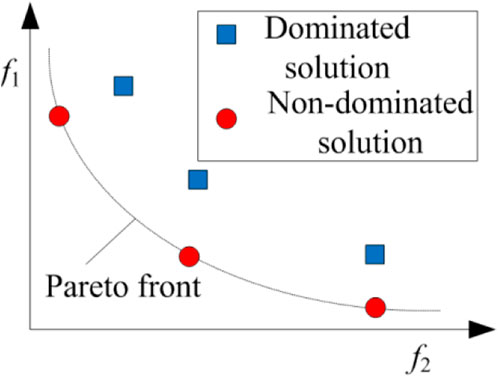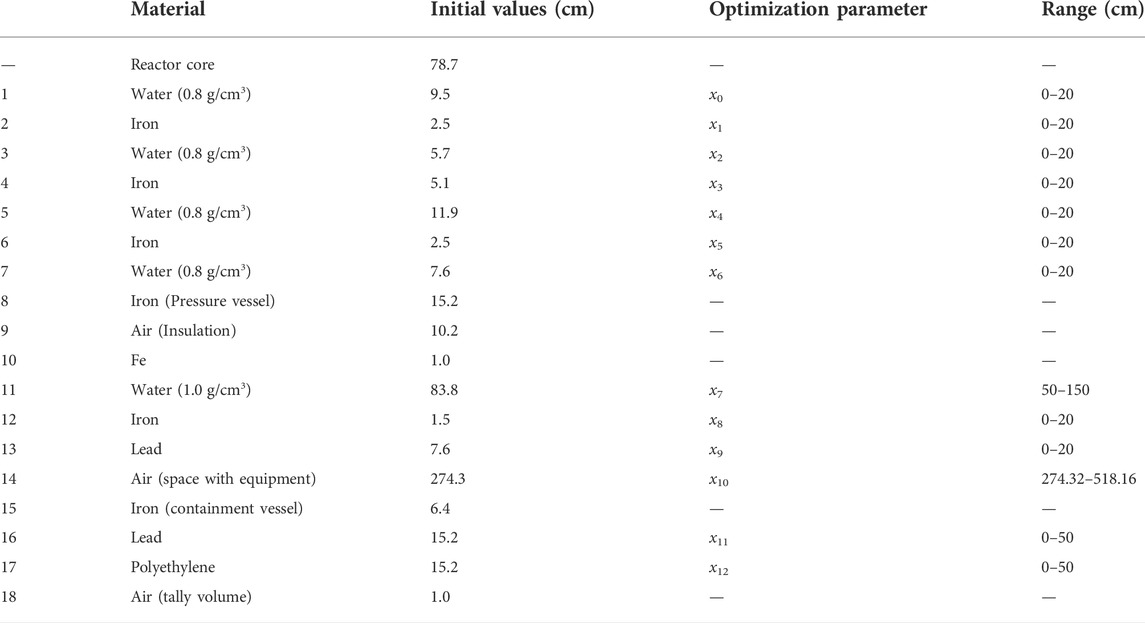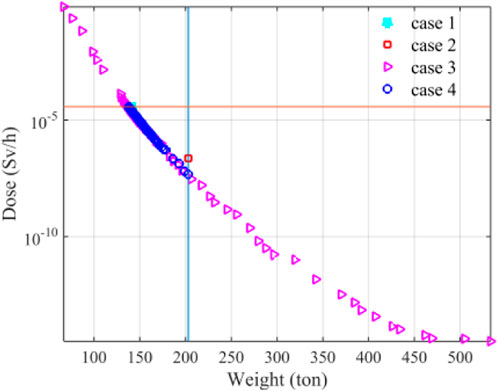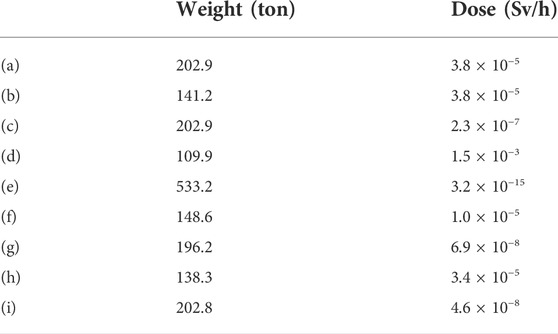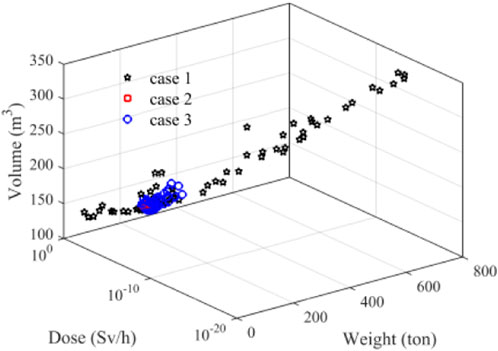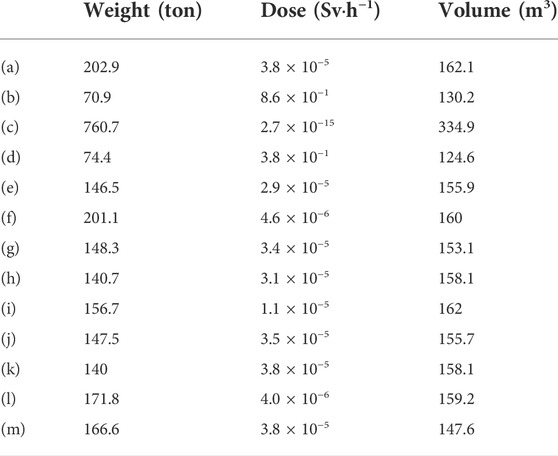- 1Science and Technology on Reactor System Design Technology Laboratory, Nuclear Power Institute of China, Chengdu, China
- 2School of Nuclear Science and Technology, Xi’an Jiaotong University, Xi’an, Shannxi, China
- 3RIKEN Center for Advanced Photonics, RIKEN, Wako, Saitama, Japan
An optimization method combining a genetic algorithm and the paralleling discrete ordinate code is developed and applied to the shielding design of the Savannah reactor. Several approaches are studied to cope with the multi-objective optimization problem, such as transforming into single-objective optimization approach, non-dominated sorting approach, and the approach of adding constraints on sub-objectives. Comparing with the current design methods, the optimization method developed in this study shows better performance since the discrete ordinate calculations are free of statistical fluctuations. The multi-objective optimization approach with constraints on sub-objectives seems to have the best performance. More optimized individuals satisfying the constraints can be obtained, and the optimized objectives show the best improvements comparing with the initial design.
1 Introduction
The radiation shielding design is of great significance for high-performance advanced nuclear reactors, such as nuclear marine propulsion systems (Yamaji and Sako, 1994), space reactors, and some other advanced nuclear systems (El-Genket, 2009). The primary purpose of the radiation shielding design is to design a shield enclosing the nuclear reactor to attenuate radiations and make the radiation dose out of the shield as low as reasonably achievable (ALARA) (Chen et al., 2019). Meanwhile, for those nuclear reactors in which space is limited, the shield also needs to be compact, light-weighted, and maybe specialized. As a result, the radiation shielding design problem can be modeled as a multi-objective optimization problem, given by
where
Conventionally, the radiation shielding structures are designed through trial-and-error procedure (Cacuci, 2010; Cai et al., 2018; Ahmad et al., 2021), which performs as follows: first, an initial shielding design is proposed according to the designer’s expertise; then the initial design is modeled and simulated with radiation transportation codes, such as Monte Carlo codes and SN (discrete ordinate) codes. Second, design objectives are analyzed. If the required objectives are not satisfied, the parameters of the shielding structure are modified according to the designer’s experience, and another solution is obtained, simulated, and analyzed. The conventional method is time-consuming, has low efficiency, and the optimal solution is always hard to obtain. In recent years, multi-objective optimization algorithms are introduced into the shielding design field. Tunes et al. (2017) combine the Matlab (Matrix Laboratory) optimization toolbox with MCNP (A General Monte Carlo N-Particle Transport Code) to optimize the biological shielding structure of a compact pressurized water nuclear reactor. Chen et al. developed the optimization method combining a non-dominated sorting algorithm with the Monte Carlo code MCNP, which is applied to the shielding design of the Savannah reactor (Chen et al., 2019; Chen et al., 2020). Wu et al. (2021) combined the PSO (Particle Swarm Optimization) multi-objective optimization algorithm with the one-dimensional SN code ANISN (A One-Dimensional Discrete Ordinates Transport Code with Anisotropic Scattering) to optimize the nuclear reactor shielding structure. In addition, the optimization methods combining multi-objective optimization algorithms with radiation transportation codes are also used to the shielding design of the accelerator-driven neutron source (Ma et al., 2021).
As is stated previously, the current multi-objective optimization methods of shielding design mainly combine multi-objective algorithms with radiation transportation codes. The non-dominated sorting algorithm is the most widely used algorithm for multi-objective optimization. Two main drawbacks exist among the current optimization methods. First, constraints of the sub-objectives are not added, so normally there are solutions of which the sub-objectives are beyond tolerable limits. In addition, the commonly used radiation transportation codes are the Monte Carlo code and one-dimensional SN code. Simulations of Monte Carlo codes are always fluctuated as a result of its statistical nature (Zhuang, et al., 2019), causing difficulty for the optimization algorithms in searching for global optimal solutions. Also, the one-dimensional SN code cannot simulate the real radiation transportation problems.
In this study, an optimization design method for the nuclear reactor radiation shielding structure is developed. The non-dominated sorting algorithm is used for multi-objective optimization. Constraints of the sub-objectives are added to ensure sub-objectives of the optimized solutions within tolerable limits. In addition, the paralleling three-dimensional SN code Hydra is used to perform the radiation transportation calculations. Hydra was developed by the NECP (Nuclear Engineering Computational Physics) laboratory which uses the Koch–Baker–Alcouffe (KBA) algorithm to perform the parallelization calculation (Wang et al., 2020). The aim of this study is to develop an accurate and efficient optimization method solving the multi-objective optimization problem of the nuclear reactor shielding design, with the optimized solutions of which sub-objectives are within the tolerable limits.
2 Methodology
Based on the optimization method, combining genetic algorithms with the paralleling SN code Hydra, several approaches are studied for the multi-objective optimization problem stated by Eq. 1, which are illustrated as follows.
2.1 Approach 1: The single-objective method
This approach converts the multi-objective optimization problem into a single-objective optimization problem by setting the other sub-objectives as constraints, given as
In order to eliminate the individuals not satisfying the constraints, the subobjectives are transformed by,
Thus, the minimization problem stated by Eq. 2 can be transformed into the maximization problem given by
As a result, the multi-objective minimization problem of the shielding design is converted into a single-objective maximization problem by treating the individuals not satisfying the constraints as “lethal genes”, of which the fitness values are set to be 0. A single-objective genetic algorithm based on elitism is applied to solve the single-objective maximization problem stated by Eq. 4 (Zhou and Sun, 1999).
2.2 Approach 2: The non-dominated sorting method
In most cases, sub-objectives of the multi-objective optimization might be conflicting with each other, so there is no single optimal solution to a given problem. Therefore, the solutions are non-dominated “Pareto optimal”, which are the trade-offs between the sub-objectives. For arbitrary given two decision vectors
Additionally, a solution
The NSGA-II (Non-dominated Sorting Genetic Algorithm) is applied to solve the multi-objective optimization problem in this study. NSGA-II is one of the most popular multi-objective optimization algorithms with three special characteristics, fast non-dominated sorting approach, fast crowded distance estimation procedure, and simple crowded comparison operator. Currently, the NSGA-II algorithm is widely used in the multi-objective optimization field (Deb et al., 2002).
2.3 Approach 3: Non-dominated sorting with sub-objective constraints
Optimization results beyond the tolerable limits may appear with direct application of the multi-objective optimization algorithm. Hence, the multi-objective optimization method with constraints of sub-objectives is studied. First, the minimization optimization problem is converted into the maximization optimization problem, given as
where the sub-objectives are defined as
Then, Eqs 7, 8 are implemented into the non-dominated sorting algorithm NSGA-II for the multi-objective optimization.
3 Results and discussion
3.1 The savannah reactor shielding model
The simplified Savannah reactor model is introduced to perform radiation shielding design optimization. The Savannah is a single-screw, combination passenger-cargo ship, which is powered by a nuclear reactor (Blizard et al., 1962). The Savannah reactor is of the pressurized water type, fueled with slightly enriched UO2. The critical core is 229.2 cm long overall, with an active fuel length of 167.6 cm and an equivalent core diameter of 157.6 cm. The initial design for the Savannah reactor shield is a simplified shield model which consists of an annulus of light water and stainless steel contained in the shield tank surrounding the reactor. The water annulus is supplemented by lead at the shield tank outer wall. The simplified shield model of the Savannah reactor is shown in Figure 2. The visualization toolkit Vised is used to visualize the geometrical structures of the reactor shielding (X-5 Monte Carlo Team, 2003).
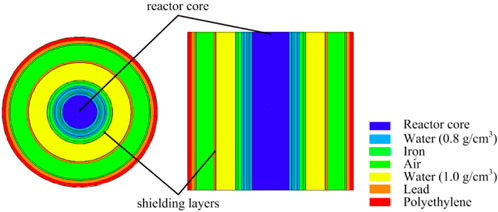
FIGURE 2. Schematic of the radial and axial cross-section of the simplified Savannah reactor shield model.
There are 18 shielding layers surrounding the reactor core. Thicknesses of the pressure vessel, air insulator, and containment vessel are considered to be fixed; thus, the number of the optimization parameters is 13. The initial layers of geometrical structures with different materials and the initial design parameters and ranges of the optimization parameters are listed in Table 1. Ranges of the optimization parameters are considered based on the engineering needs of the Savannah reactor (Blizard et al., 1962).
3.2 The optimization objectives
For the Savannah reactor, the purpose of optimizing is to obtain a lightweight and compact shielding structure with the radiation dose in the tally volume lower than the tolerable limit. Hence, the three optimization objectives are the shielding weight, radiation dose in the tally volume, and volume of the shielding structure, denoted as fW, fD, and fV, respectively. In addition, the fast neutron flux (> 1.0 MeV) at the pressure vessel should be lower than the tolerable limit value to ensure the operation life of the reactor, so the fast neutron flux at the pressure vessel, denoted as f4, acts as a constraint during the optimization.
The shielding weight, volume, radiation dose in the tally volume, and fast neutron flux at the pressure vessel of the initial design of the Savannah reactor perform as the tolerable limits of the sub-objectives during the optimization. The paralleling SN code Hydra is applied to perform the radiation transport simulation. Fixed-source calculations with one source iteration are performed in the S16-P3 approximation, where S16 indicates the flux angular discretization is 16 and P3 indicates the order of the expansion in Legendre polynomials of the scattering cross-section is 3. The BUGLE-96 (Broad User Group Library ENDF/B) cross-section library, specifically produced for LWR (Light-Water Reactor) shielding and dosimetry applications, is used in the Hydra calculations. BUGLE-96 is based on the ENDF/B-VI (Evaluated Nuclear Data File) Release 3 evaluated data and is available in the FIDO (Floating Index Data Operation) ANISN format (White et al., 1996). The MCNP code is also carried out to calculate the tolerable limits of the sub-objectives, listed in Table 2. The relative deviation between the Hydra code and the MCNP code for fV,0 and f4,0 are 8 and 8.7%, respectively, indicating that the accuracy of Hydra code is sufficient for optimization.
In order to keep the sub-objectives to the same scale, the sub-objectives are normalized using the following method, given by
where
3.3 The optimization algorithm parameter’s setting
Population size used in the optimization is 70, and the number of generations is 100. The SBX (Simulated Binary Crossover) operator is adopted with the crossover rate of 0.9. The polynomial mutation operator is used with the mutation rate of 0.2.
3.4 The optimization results
3.4.1 Optimization with two objectives
First, situations with two competing sub-objectives are studied, i. e., the shielding weight and radiation dose in the tally volume. Four cases are studied in this section. The optimization approach and objectives of each case are illustrated in Table 3. The optimized objectives (for case 1 and case 2) and the Pareto fronts (for case 3 and case 4) are illustrated in Figure 3.
As is shown in Figure 3, the optimized objectives of case 1 and case 2 are close to the Pareto front of case 3. The Pareto front curve of case 4 overlaps with the Pareto front curve of case 3. For the optimization results of case 3, there are 35 individuals of which the sub-objectives are within the tolerable limits. However, for the optimization results of case 4, there are 70 individuals of which the sub-objectives are within the tolerable limits, indicating that more optimized individuals can be obtained by applying constraints on the sub-objectives for optimization.
The geometrical structures of the initial design and eight typical individuals picked from the optimization results of the four cases are studied and shown in Figure 4. The eight typical optimized individuals are the optimized individuals of case 1, case 2, and case 3 with minimal weight, case 3 with minimal dose, case 3 with minimal weight under tolerable limits, case 3 with minimal dose under tolerable limits, case 4 with minimal weight, and case 4 with minimal dose.
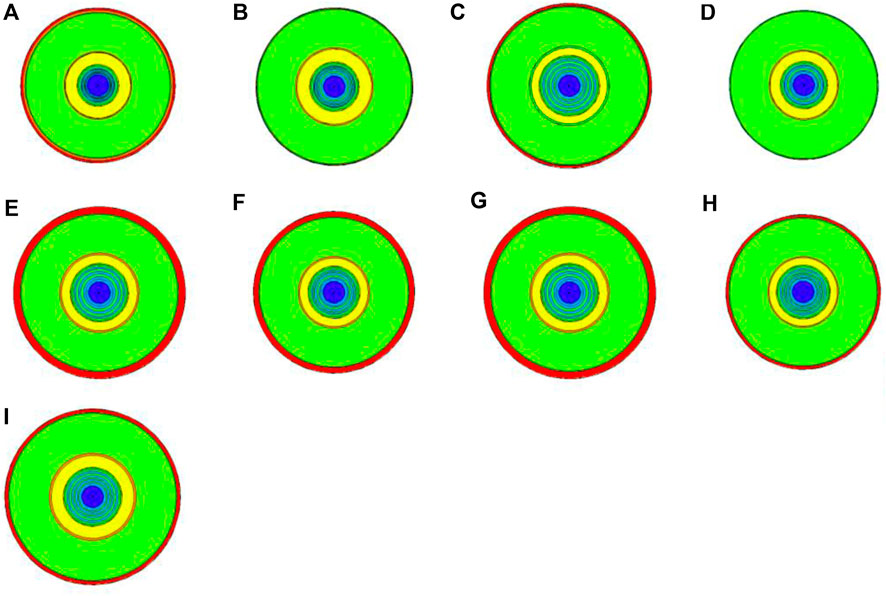
FIGURE 4. Cross-sections of the geometrical structures of the initial design and typical individuals after optimization; (A) initial design; (B) case 1; (C) case 2; (D) case 3 with minimal weight; (E) case 3 with minimal dose; (F) case 3 with minimal weight within tolerable limits; (G) case 3 with minimal dose within tolerable limits; (H) case 4 with minimal weight; and (I) case 4 with minimal dose.
Comparing with the initial design, the optimized structures are oriented by the optimization objectives. As for the two competing sub-objectives, the optimized structure with minimal weight appears to have the maximal dose and vice versa, as shown in Figures 4D,E. The other individuals show the same pattern. The sub-objectives of the optimized individuals in Figure 4 are listed in Table 3. It can be seen that the optimization result with approach 3 contains the best individuals with sub-objectives under the tolerable limits, shown (h) and (i) in Table 4. Comparing with the initial design, the optimized weight can be reduced by 31.8% (h) and the radiation dose can be reduced by ∼ three orders of magnitude (i).
3.4.2 Optimization with three objectives
Optimizations with two competing sub-objectives are studied in Section 3.4.1, and the results agree well with the theoretical anticipation. In this part, optimizations with three sub-objectives are also studied. The sub-objective dose is competing with the other two sub-objectives, i e., weight and volume. The sub-objectives weight and volume are positively correlated, however not equivalent. Three cases are studied in this section. The optimization approach and limit value of the weight of the cases are illustrated in Table 5.
Pareto fronts of the three cases are shown in Figure 5.
The number of the optimized individuals of which the sub-objectives are under the tolerable limits for the three cases is 9, 13, and 27. The “relaxation” is effective for the tight limitation that generates too many lethal genes which may cause difficulty for the algorithm searching for the optimal solutions.
The geometric structures of the initial design and the typical optimized individuals are shown in Figure 6. The typical optimized individuals are as follows: case 1 with minimal weight, case 1 with minimal dose, case 1 with minimal volume, case 1 with minimal weight within the tolerable limits, case 1 with minimal dose within the tolerable limits, case 1 with minimal volume within the tolerable limits, case 2 with minimal weight, case 2 with minimal dose, case 2 with minimal volume, case 3 with minimal weight, case 3 with minimal dose, and case 3 with minimal volume.
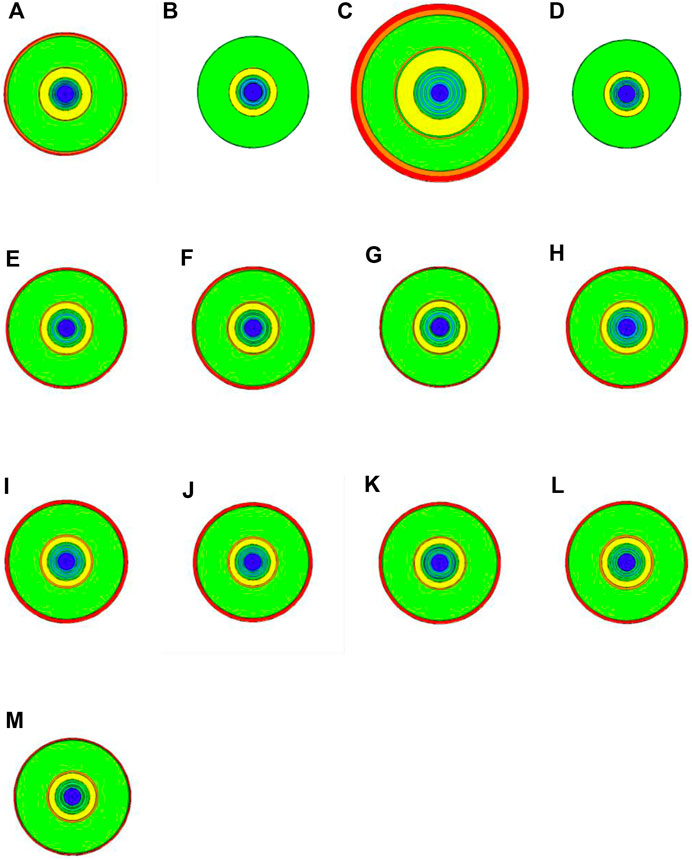
FIGURE 6. Cross-sections of the geometrical structures of the initial design and typical individuals after optimization; (A) initial design; (B) case 1 with the minimal weight; (C) case 1 with the minimal dose; (D) case 1 with the minimal volume; (E) case 1 with the minimal weight within the tolerable limits; (F) case 1 with the minimal dose within the tolerable limits; (G) case 1 with the minimal volume within the tolerable limits; (H) case 2 with minimal weight; (I) case 2 with minimal dose; (J) case 2 with minimal volume; (K) case 3 with minimal weight; (L) case 3 with minimal dose; and (M) case 3 with minimal volume.
Similar to the optimization results in Section 3.4.1, the optimized structures are oriented by the optimization objectives. As for the competing sub-objectives, i. e., weight and dose, the optimized structure with minimal weight appears to have the maximal dose and vice versa, as shown in Figures 6B,C. Also, as for the two positively correlated sub-objectives, i. e., weight and volume, the optimized structures are also positively correlated, as shown in Figures 6B,D.The other individuals show the same pattern. The sub-objectives of the initial design and the typical optimized individual are listed in Table 6. It can be seen that the optimization result with method 3 with “relaxation” contains best individuals with sub-objectives under the tolerable limits, shown as (k), (l), and (m) in Table 6. Comparing with the initial design, the optimized weight (k), the optimized radiation dose (l), and the optimized volume (m) are reduced by 31.0, 89.4, and 9.0%, respectively.
Comparing with the optimized results of Section 3.4.1, the optimized individuals with minimum weight and dose are a little higher. Increase of the sub-objectives may cause difficulty for the optimization algorithm searching for optimal solutions.
4 Conclusion
An optimization method combining the non-dominated sorting genetic algorithm with the paralleling 3-dimensional SN code is developed and applied to radiation shielding design of the Savannah reactor. Better performances of the radiation shielding structure can be obtained through optimization. For example, as for the optimization with two objectives, the optimized shielding weight and radiation dose can be reduced by 31.8% and ∼3 orders of magnitude, respectively. The optimized shielding weight, radiation dose, and shielding volume of the optimization with the three objectives are reduced by 31.0, 8.4, and 9.0%, respectively. The developed method is meaningful for lightweight and compact design of nuclear reactors. However, sub-objectives that the developed method can process are too few to shielding design of some types of reactors with special purposes, so optimization design method processing many sub-objectives (∼10) is to be developed in the future.
Data availability statement
The raw data supporting the conclusion of this article will be made available by the authors, without undue reservation.
Author contributions
BL designed the research and wrote the paper; YT raised valuable questions that help improving the paper; FJ performed the HYDRA calculations; GH conducted the research and performed the genetic algorithm; MY performed the MCNP calculations.
Conflict of interest
The authors declare that the research was conducted in the absence of any commercial or financial relationships that could be construed as a potential conflict of interest.
Publisher’s note
All claims expressed in this article are solely those of the authors and do not necessarily represent those of their affiliated organizations, or those of the publisher, the editors, and the reviewers. Any product that may be evaluated in this article, or claim that may be made by its manufacturer, is not guaranteed or endorsed by the publisher.
References
Ahmad, S., Chang, B., Li, B., Qi, Y., and Liu, C. (2021). Mass optimization of the radiation shadow shield for space nuclear power system. Prog. Nucl. Energy 131 (1), 103607. doi:10.1016/j.pnucene.2020.103607
Blizard, E. P., Blosser, T. V., and Freestone, R. M. (1962). The radiation leakage survey of the shield of the nuclear ship Savannah. ORNL-3336. United States: Oak Ridge National Laboratory.
Cai, Y., Hu, H. S., Lu, S. Y., and Jia, Q. (2018). Optimization of radiation shielding material aiming at compactness, lightweight, and low activation for a vehicle-mounted accelerator-driven D-T neutron source. Appl. Radiat. Isotopes 135, 147–154. doi:10.1016/j.apradiso.2018.01.021
Chen, Z. P., Zhang, Z. Y., Xie, J. S., Guo, Q., and Yu, T. (2019). Metaheuristic optimization method for compact reactor radiation shielding design based on genetic algorithm. Ann. Nucl. Energy 134 (1), 318–329. doi:10.1016/j.anucene.2019.06.031
Chen, Z. P., Zhang, Z. Y., Xie, J. S., Guo, Q., Yu, T., Zhao, P., et al. (2020). Multi-objective optimization strategies for radiation shielding design with genetic algorithm. Comput. Phys. Commun. 260 (1), 107267. doi:10.1016/j.cpc.2020.107267
Deb, K., Pratap, A., Agarwal, S., and Meyarivan, T. (2002). A fast and elitist multi-objective genetic algorithm: NSGA-II. IEEE Trans. Evol. Comput. 6 (2), 182–197. doi:10.1109/4235.996017
El-Genk, M. S. (2009). Deployment history and design considerations for space reactor power systems. Acta Astronaut. 64 (1), 833–849. doi:10.1016/j.actaastro.2008.12.016
Ma, B. L., Song, L., Yan, M. F., Ikeda, Y., Otake, Y., and Wang, S. (2021). Multi-objective optimization shielding design for compact accelerator-driven neutron sources by application of NSGA-II and MCNP. IEEE Trans. Nucl. Sci. 68 (2), 110–117. doi:10.1109/tns.2020.3040500
Tunes, M. A., de Oliveira, C. R. E., and Schon, C. G. (2017). Multi-objective optimization of a compact pressurized water nuclear reactor computational model for biological shielding design using innovative materials. Nucl. Eng. Des. 313 (1), 20–28. doi:10.1016/j.nucengdes.2016.11.009
Wang, Y. P., Zheng, Y. Q., Xu, L. F., and Cao, L. (2020). NECP-Hydra: A high-performance parallel SN code for core-analysis and shielding calculation. Nucl. Eng. Des. 366 (1), 1107111–1107118. doi:10.1016/j.nucengdes.2020.110711
White, J. E., Ingersoll, D. T., and Wright, R. Q., (1996). Production and testing of the revised VITAMIN-B6 fine-group and the BUGLE-96 broad-group neutron/photon cross section libraries derived from ENDF/B-BI.3 nuclear data, NUREG/CR-6214, Revision 1, ORNL-6795/R1.
Wu, X., Yang, Y. W., Han, S., Zhao, Z., Fang, P., and Gao, Q. (2021). Multi-objective optimization method for nuclear reactor radiation shielding design based on PSO algorithm. Ann. Nucl. Energy 160 (1), 108404. doi:10.1016/j.anucene.2021.108404
X-5 Monte Carlo Team (2003). MCNP-A general N-particle transport code. New Mexico: Los Alamos National Laboratory.
Yamaji, A., and Sako, K. (1994). Shielding design to obtain compact marine reactor. J. Nucl. Sci. Technol. 31 (6), 510–520. doi:10.1080/18811248.1994.9735185
Zhou, M., and Sun, S. D. (1999). Genetic algorithms: Theory and applications. Beijing, China: National Industrial Press.
Keywords: multi-objective optimization, genetic algorithm, Pareto optimality, paralleling SN code, nuclear reactor shielding
Citation: Liu B, Tan Y, Jing F, Hu G and Yan M (2022) Study on multi-objective optimization for nuclear reactor radiation shield design coupling genetic algorithm with paralleling discrete ordinate code. Front. Energy Res. 10:935648. doi: 10.3389/fenrg.2022.935648
Received: 04 May 2022; Accepted: 21 July 2022;
Published: 17 August 2022.
Edited by:
Shripad T. Revankar, Purdue University, United StatesReviewed by:
Gerardo Maria Mauro, University of Sannio, ItalyJiankai Yu, Massachusetts Institute of Technology, United States
Copyright © 2022 Liu, Tan, Jing, Hu and Yan. This is an open-access article distributed under the terms of the Creative Commons Attribution License (CC BY). The use, distribution or reproduction in other forums is permitted, provided the original author(s) and the copyright owner(s) are credited and that the original publication in this journal is cited, in accordance with accepted academic practice. No use, distribution or reproduction is permitted which does not comply with these terms.
*Correspondence: Bin Liu, bGl1YmluODcxMjA0QDEyNi5jb20=; Yi Tan, c2hhcnB0eUBzaW5hLmNvbQ==; Guang Hu, Z3VhbmdodUBtYWlsLnhqdHUuY24=
 Bin Liu
Bin Liu Yi Tan1*
Yi Tan1*